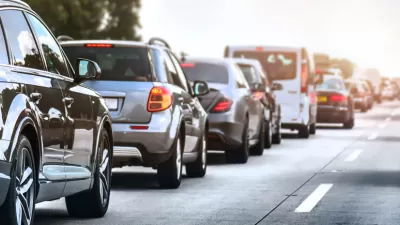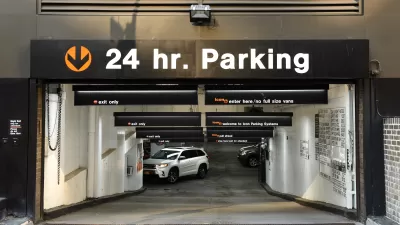A few weeks ago the Texas Transportation Institute (TTI) released its latest Urban Mobility Report, and yesterday INRIX released its National Traffic Scorecard 2010 Annual Report. Both paint a grim picture of roadway conditions. “America is back on the road to gridlock,” warns INRIX.
A few weeks ago the Texas Transportation Institute (TTI) released its latest Urban Mobility Report, and yesterday INRIX released its National Traffic Scorecard 2010 Annual Report. Both paint a grim picture of roadway conditions.
"America is back on the road to gridlock," warns INRIX.
"Congestion costs continue to rise: measured in constant 2009 dollars, the cost of congestion has risen from $24 billion in 1982 to $115 billion in 2009," warns TTI.
Be afraid! Be very afraid!
Be afraid of the hyperbole. These studies greatly exaggerate estimated congestion costs.
Let's put this into perspective. INRIX's analysis indicates that congestion delays add about 10% duration to an average urban-peak freeway trip. TTI analysis indicates that congestion delays and traffic incidents add about 20% duration to urban-peak freeway and arterial trips. For example, a typical urban automobile commute, 2/3 of which is on arterials and freeways, that takes 30 minutes under uncongested conditions will take 32-34 minutes during peak periods. Since only about 15% of total vehicle travel occurs under these conditions, this indicates that traffic congestion adds 1-3% to total motor vehicle travel times.
This is hardly a crisis.
The TTI and INRIX methodologies greatly exaggerate true congestion costs. As discussed in economist Joe Cortright report, Driven Apart: How Sprawl is Lengthening Our Commutes and Why Misleading Mobility Measures are Making Things Worse these studies assume that freeflow travel is optimal although that would be economically inefficient; use excessively high travel time values; exaggerate the increased fuel consumption caused by congestion; and ignore the increased transportation costs resulting from more dispersed land development. These methodologies actually imply that increases in uncongested highway driving, for example due to sprawl, reduce congestion costs because delays are divided by more total miles driven.
A more rational method for calculating congestion costs is to test consumers' willingness-to-pay for reduced delay. This approach usually results in much smaller congestion cost values. Despite all the complaining about congestion, a recent public survey found that, although Americans consider transportation infrastructure improvements important, they strongly oppose new fuel taxes, road tolls or VMT fees to reduce this problem. Even New York City has failed to implement congestion tolls. That users are unwilling to pay for reduced congestion indicate that the TTI cost estimates are greatly exaggerated.
Unfortunately, the Texas Transportation Institute has so far ignored this criticism. Neither their reports nor their website acknowledge Cortright's report or other critiques of their methodologies. Most users of this information have no idea of the biases and distortions in these studies.
The truth is, traffic congestion tends to maintain equilibrium: it gets bad enough consumers shift some peak period driving to other times, modes or destinations. Simply expanding roadways cannot reduce congestion over the long-run since generated traffic eventually fills the added capacity, often within months or a few years. Truly reducing congestion requires improving travel alternatives, such as grade-separated public transit, and more efficient road and parking pricing.
People sometimes extrapolate traffic growth trends, and warn that roads will soon reach gridlock unless some action is taken. Such claims ignore traffic congestion's tendency toward equilibrium. Gridlock is a specific condition that occurs when backups in a street network block intersections, stopping traffic flow. Gridlock can be avoided with proper intersection design and traffic law enforcement. Increasing regional highway capacity tends to increase this risk by adding more traffic to surface streets where gridlock occurs.
This is not to deny that congestion is a problem, particularly because it is unpredictable and so adds stress and uncertainty to driving, but it is important to put it into perspective. It is one of many transportation problems. It is foolish to implement traffic congestion reduction strategies that exacerbate other problems, such as high consumer costs, parking problems, accidents and pollution emissions. Society benefit far more from win-win solutions that reduce congestion in ways that also achieve other planning objectives. For example, expanding highways or using telematics (electronic vehicle control systems) to squeeze more vehicles onto existing highways at best reduces traffic congestion on a few highway links, but by inducing additional vehicle travel these strategies tend to exacerbate downstream traffic and parking congestion, accidents, energy consumption and pollution emissions. In contrast, grade separated public transit (rail and bus lanes), more efficiently road and parking pricing, and more accessible land use development are examples of congestion reduction strategies that provide additional benefits.
For More Information
Md Aftabuzzaman, Graham Currie and Majid Sarvi (2010), "Evaluating the Congestion Relief Impacts of Public Transport in Monetary Terms," Journal of Public Transportation, Vol.13, No. 1, pp. 1-24; at www.nctr.usf.edu/jpt/pdf/JPT13-1.pdf.
Robert L. Bertini (2005), You Are the Traffic Jam: An Examination of Congestion Measures, TRB Annual Meeting (www.trb.org); at www.its.pdx.edu/pdf/congestion_trb.pdf.
Joe Cortright (2010), Driven Apart: How Sprawl is Lengthening Our Commutes and Why Misleading Mobility Measures are Making Things Worse, CEOs for Cities (www.ceosforcities.org); at www.ceosforcities.org/work/driven-apart.
Susan Grant-Muller and James Laird (2007), International Literature Review of the Costs of Road Traffic Congestion, Scottish Executive (www.scotland.gov.uk); at www.scotland.gov.uk/Publications/2006/11/01103351/0.
Todd Litman (2001), "Generated Traffic; Implications for Transport Planning," ITE Journal, Vol. 71, No. 4, ITE (www.ite.org), April, pp. 38-47; at www.vtpi.org/gentraf.pdf.
Todd Litman (2006), Smart Congestion Reductions: Reevaluating the Role of Highway Expansion for Improving Urban Transportation, Victoria Transport Policy Institute (www.vtpi.org); at www.vtpi.org/cong_relief.pdf.
Todd Litman (2009), "Congestion Costs," Transportation Cost and Benefit Analysis, Victoria Transport Policy Institute (www.vtpi.org); at www.vtpi.org/tca/tca0505.pdf.
VTPI (2006), "Congestion Reduction Strategies" Online TDM Encyclopedia (www.vtpi.org); at www.vtpi.org/tdm/tdm96.htm.

Planetizen Federal Action Tracker
A weekly monitor of how Trump’s orders and actions are impacting planners and planning in America.

Map: Where Senate Republicans Want to Sell Your Public Lands
For public land advocates, the Senate Republicans’ proposal to sell millions of acres of public land in the West is “the biggest fight of their careers.”

Restaurant Patios Were a Pandemic Win — Why Were They so Hard to Keep?
Social distancing requirements and changes in travel patterns prompted cities to pilot new uses for street and sidewalk space. Then it got complicated.

Platform Pilsner: Vancouver Transit Agency Releases... a Beer?
TransLink will receive a portion of every sale of the four-pack.

Toronto Weighs Cheaper Transit, Parking Hikes for Major Events
Special event rates would take effect during large festivals, sports games and concerts to ‘discourage driving, manage congestion and free up space for transit.”

Berlin to Consider Car-Free Zone Larger Than Manhattan
The area bound by the 22-mile Ringbahn would still allow 12 uses of a private automobile per year per person, and several other exemptions.
Urban Design for Planners 1: Software Tools
This six-course series explores essential urban design concepts using open source software and equips planners with the tools they need to participate fully in the urban design process.
Planning for Universal Design
Learn the tools for implementing Universal Design in planning regulations.
Heyer Gruel & Associates PA
JM Goldson LLC
Custer County Colorado
City of Camden Redevelopment Agency
City of Astoria
Transportation Research & Education Center (TREC) at Portland State University
Camden Redevelopment Agency
City of Claremont
Municipality of Princeton (NJ)






























